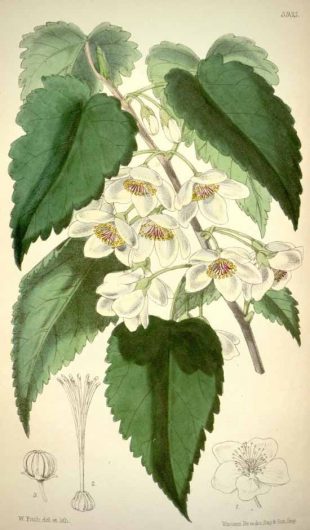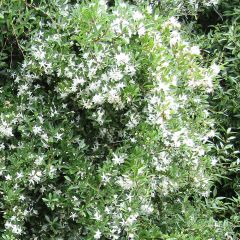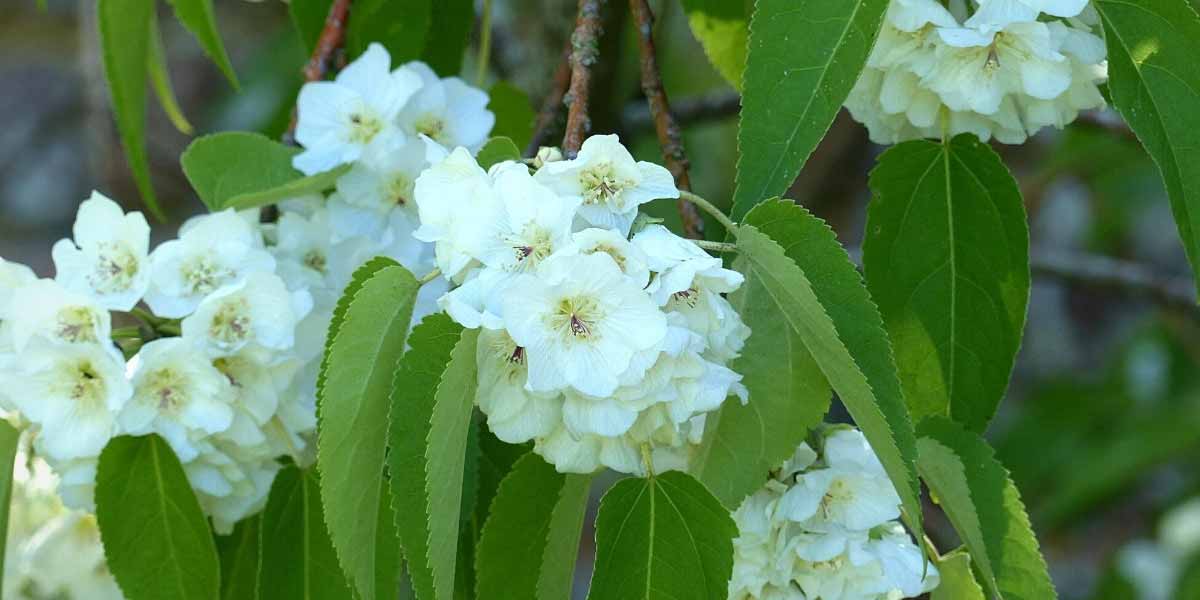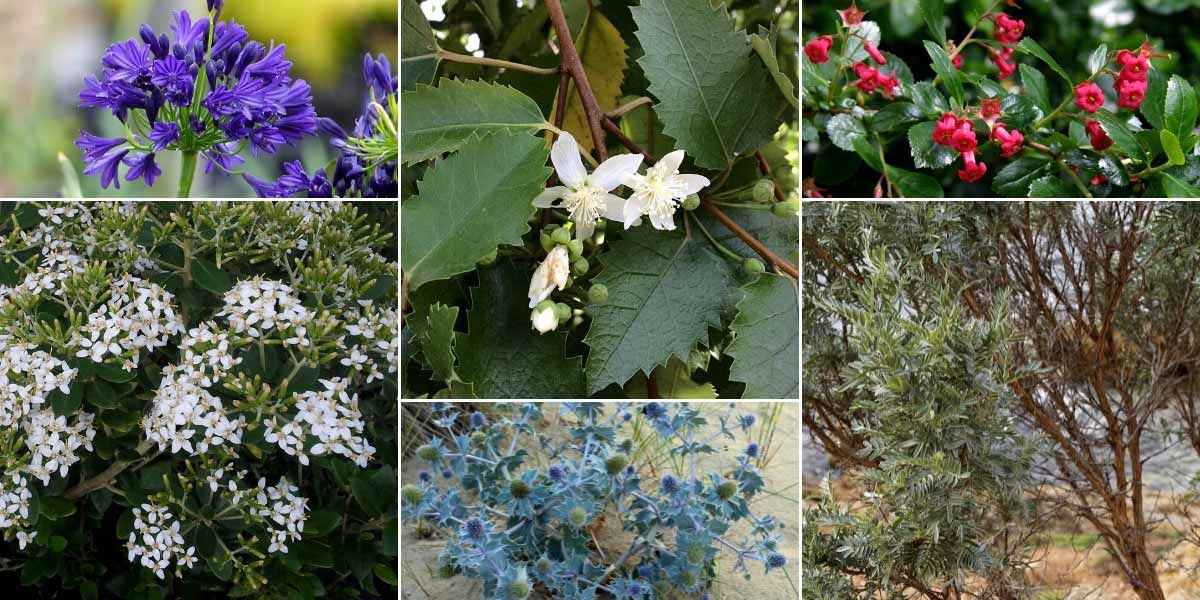
Hoheria: Planting, Growing and Caring
Contents
The Hoheria in a nutshell
- Hoheria are little-known and rare trees and bushes in cultivation
- They are native to New Zealand
- In summer, they are covered with countless star-shaped white flowers
- They bear beautiful dentate foliage, usually evergreen
- They thrive in mild and humid climates, and are particularly suited to the Atlantic coast
The word from our expert
Hoheria are trees and bushes native to New Zealand, with a narrow, flexible habit and generally evergreen foliage. They are prized for their abundant white flowering in midsummer! At this time, they produce a multitude of small, star-shaped white flowers with five petals, adorned with decorative stamens. Discover, for example, the splendid Hoheria sexstylosa ‘Snow White’, with its evergreen foliage and delicate, lightly scented flowering. Hoheria also boast beautiful dark green, dentate leaves. There are several varieties with colourful foliage: for example, Hoheria populnea ‘Variegata’, with leaves variegated in yellow, or Hoheria populnea ‘Alba Variegata’, with leaves marginate in creamy white.
Hoheria are particularly well-suited to the Atlantic coast, especially Brittany and Normandy, where they can enjoy a mild and humid climate. Moreover, they tolerate sea spray! They can, however, be cultivated further inland, as they are adaptable and relatively hardy: Hoheria sexstylosa, for example, can withstand temperatures as low as –15°C. Nevertheless, choose a location sheltered from cold winds. They will thrive in full sun or partial shade, in fresh, well-draining soil, preferably neutral or chalky. Once established, they require little maintenance. Discover all our tips for successfully growing Hoheria!
botany
Botanical data
- Latin name Hoheria sp.
- Family Malvaceae
- Common name Hoheria
- Flowering July-August
- Height 3-4 m, sometimes up to 8 m
- Exposure sun or partial shade
- Soil type moist and well-drained
- Hardiness generally between – 8 and – 12 °C, sometimes down to – 15 °C
Hoheria comprises 8 species of columnar shrubs or small trees, endemic to New Zealand. They grow in undergrowth, on forest edges, and along watercourses. Although cultivated in Australia, New Zealand, and Great Britain, in France they are still little known and very rare in gardens. However, they have beautiful ornamental qualities, with their generous summer flowering and their dentate, generally evergreen foliage. Regarding their hardiness, they can withstand temperatures of around -8 to -12 °C in well-drained soil, depending on the species. The Hoheria sexstylosa is one of the most cold-resistant, tolerating temperatures as low as -15 °C.
Although still rarely cultivated in France, Hoheria includes many horticultural varieties (resulting from cross-breeding efforts by British horticulturists and nurserymen). The cultivars of the species Hoheria populnea stand out particularly for their colourful foliage, often variegated with yellow or white. The stunning variety ‘Glory of Amlwch’ originated from a natural cross that occurred in the village of Amlwch, in northern Wales, between Hoheria glabrata and Hoheria sexstylosa.

Hoheria lyallii: Botanical illustration
Hoheria belongs to the Mallow family, Malvaceae. This family includes many ornamental plants, such as hollyhocks, lavateras, althaeas, hibiscus, abutilons, sidalceas… as well as the lime tree and the baobab!
The name Hoheria comes from the Maori word houhere. In English, they are nicknamed lacebark (lacerate bark) and ribbonwood (ribbon wood). Be careful not to confuse them with Homeria, small South African bulbous plants.
Hoheria has an upright and narrow but very flexible habit. They typically reach 3-4 m in height, but can sometimes grow up to 8 m, or even 10 m in their natural environment. The Hoheria sexstylosa ‘Pendula’ stands out for its weeping habit. Some species have decorative bark: this is the case for Hoheria sexstylosa, whose bark is adorned with white, brown, and grey-green patches. The Hoheria populnea, on the other hand, has exfoliating bark.
Hoheria offers abundant white flowering in summer, usually in July-August. The flowers measure 1 to 3 cm in diameter, are star-shaped, and consist of five petals and five sepals. They are inserted in the axil of the leaves and can be solitary or grouped in clusters. The flowers are hermaphroditic, with numerous stamens (male reproductive parts, bearing pollen) and a pistil (female reproductive part, receiving pollen) at their centre. The pistil is usually divided into five styles (six in the species H. sexstylosa).
The flowers are melliferous, attracting butterflies and bees that come to feed on their nectar. While feeding, they pollinate the flowers, enabling reproduction.

The flowering of Hoheria populnea, Hoheria angustifolia (photo: Chris Fort), and Hoheria lyallii
Most Hoheria are evergreen to semi-evergreen (they may lose their leaves in severe winters), but a few species (Hoheria glabrata, H. lyallii) are deciduous. The foliage of Hoheria glabrata turns a beautiful yellow in autumn before falling.
The leaves of Hoheria are entire, undivided, ovate to lanceolate in shape, with beautifully dentate or crenate leaf margins. They are alternate, inserted one after another on the stems. Juvenile leaves are sometimes lobed and display metallic reflections, while adult leaves are dark green, often with a lighter, grey-green underside. Hoheria foliage is fairly ordinary, but the Hoheria populnea comes in several varieties with colourful foliage: ‘Variegata’ has leaves variegated with yellow, those of ‘Alba Variegata’ are margined with creamy white, while those of ‘Purple Wave’ are beautifully coloured purple on the underside.
Once the flowers fade, they give way to capsules that may or may not be winged, depending on the species. When growing conditions suit them, Hoheria tends to self-seed spontaneously.

The crenate and cordate foliage of Hoheria glabrata, the lanceolate leaves of Hoheria lyallii and Hoheria populnea (photos: Krzysztof Ziarnek), and the fine, dentate leaves of Hoheria angustifolia (photo: André Chalmers)
Read also
10 perfect bushes for a seaside gardenThe main varieties
The Most Popular Varieties

Hoheria sexstylosa Snow White
- Flowering time August, September
- Height at maturity 4 m
Discover other Hoheria
View all →Available in 1 sizes
Planting
Where to Plant?
Hoherias thrive in maritime climates, mild and humid. They will flourish along the Atlantic coast, particularly in Brittany and Normandy. They tolerate sea spray and can be used near the coast to create a tall windbreak hedge. Regarding exposure, they prefer full sun or partial shade, in a location sheltered from cold winds. If you live in northern France, you can plant them against a south-facing wall.
Hoherias enjoy humus-rich, fresh but well-drained soil. They tolerate most soil types, except heavy clay soils. As for pH, they prefer neutral or calcareous soils but can also tolerate slightly acidic soils.
Hoherias can be grown as a free hedge, as a standalone plant, or in a shrub border. They are not suitable for container cultivation.
When to Plant?
We recommend planting Hoherias in spring, once the risk of frost has passed. If you live in a region with a mild climate, you can plant them in autumn, around September.
How to Plant?
- Start by placing the root ball in a basin filled with water to rehydrate it.
- Dig a large planting hole, at least twice the size of the root ball.
- Mix leaf compost and coarse sand into the planting soil (for drainage).
- Place the Hoheria in the hole, ensuring it is centred and the trunk is straight.
- Fill the hole with soil.
- Optionally, create a watering basin to help water infiltrate around the base.
- Water generously.
- We recommend applying a layer of mulch around the base.

Hoheria lyallii
Read also
10 evergreen shrubs for coastal gardensMaintenance
Continue watering during the first two summers in case of drought: the Hoheria appreciates moist soil in summer. Do not hesitate to place a thick layer of organic mulch at its base (dead leaves, straw, wood chips, etc.). This will help keep the soil cool while protecting it from the cold in winter (as its roots are shallow). If the Hoheria is still young, you can temporarily cover it with winter fleece in case of severe frost. Even if its branches freeze, the stump of the Hoheria should produce new shoots in spring.
The Hoheria does not require pruning, except if you notice damaged, poorly positioned, or frozen branches. In this case, carry out light pruning in early spring or late summer, once flowering has finished.
The Hoheria is rarely affected by parasitic insects but can be attacked by rust, a fungal disease favoured by warm and humid weather. It is identified by discoloured spots on the upper side of the leaves, as well as orange-brown pustules on the underside and stems. This weakens the bush, limiting its flowering and growth. We recommend treating it with Bordeaux mixture or sulphur. Feel free to consult our advice sheet “Getting rid of rust disease”.
More seriously, Hoherias are sometimes affected by coral spot disease. This is a severe fungal disease, causing the dieback of shoots and branches and mainly affecting trees and bushes already weakened by injury or illness. Highly virulent, this disease spreads quickly from one plant to another. It is identified by the appearance of round pustules, 0.5 to 1 cm in diameter, pink or red in colour, which later darken. If you spot them, cut off and burn the affected shoots, apply pruning sealant, and spray with a fungicide such as Bordeaux mixture. As a preventive measure, remember to disinfect your pruning tools. For more information, check out our advice sheet “How to avoid coral spot disease?”.
Multiplication
The Hoheria can be propagated by sowing or by semi-lignified stem cuttings. Layering is also possible (air layering or ground layering).
Sowing
Sowing is done in autumn (as soon as the seeds are ripe) under a cold frame. It is easy to succeed and generally yields good results.
- Prepare pots with special sowing compost, fine and light, then lightly firm and level the surface.
- Sow the seeds by placing them on the surface.
- Cover them with a thin layer of compost.
- Water with a fine spray.
- Place the pots under a cold frame, in a bright location but out of direct sunlight.
- Continue to water regularly to keep the substrate slightly moist until germination. You can then space out the watering.
Propagation by Cuttings
Take semi-lignified cuttings in late summer, in August or September.
- Take a healthy, semi-ripe stem (lignified at the base and tender at the tip), 8 to 10 cm long, cutting just below a node (the point where leaves attach to the stem).
- Remove the leaves from the lower part, leaving only 2 or 3 at the top of the stem.
- Prepare a pot with fine, light, and well-draining compost, then water it thoroughly to ensure it is moist.
- Plant the stem in the substrate.
- Firm the compost around it.
- Place the pot under a cold frame, sheltered from direct sunlight.
- Ensure the substrate remains slightly moist.
Association
Thriving in maritime climates, Hoheria are perfect for coastal gardens. Pair them with other salt-tolerant bushes, such as Griselinia littoralis, the strawberry tree (Arbutus unedo), Pittosporum tobira, and the tamarisk, which offers countless small, delicate pink flowers. Take the opportunity to create a windbreak hedge with the dense, evergreen foliage of Elaeagnus ebbingei or Olearia traversii. Also consider coastal perennials, such as Eryngium maritimum, Delosperma, Armeria maritima, and agapanthus.
Discover our advice sheet “10 Perfect Bushes for Coastal Gardens”, as well as our full range of coastal bushes.

You can pair Hoheria with coastal bushes and perennials. Agapanthus ‘Royal Velvet’, Hoheria populnea (photo Muriel Bendel), Escallonia rubra ‘Crimson Spire’ (photo Ben Rushbrooke), Olearia x haastii, Eryngium maritimum, and Anthyllis barba-jovis
Hoheria also pair beautifully with summer-flowering bushes. Consider, for example, the long conical inflorescences of butterfly bushes, the lovely pink or mauve flowers of hibiscus, and the large spherical or umbel inflorescences of Hydrangea macrophylla. You can also use them to create a mixed hedge, with abelias, privets, chaste trees, rugosa roses, and spireas. Don’t hesitate to pair them with Eucryphia, lesser-known trees that produce stunning white or pink, fragrant flowers in summer.
Useful resources
- Discover our range of Hoheria
- Our advice sheets “7 Trees for a Seaside Garden” and “10 Perfect Bushes for a Seaside Garden”
- Our range of summer-flowering bushes
- Subscribe!
- Contents
































Comments